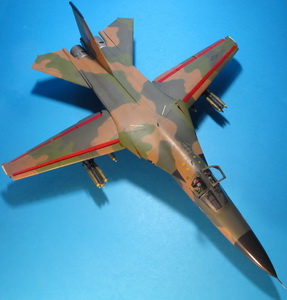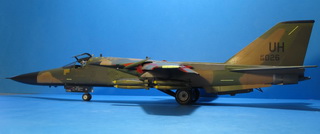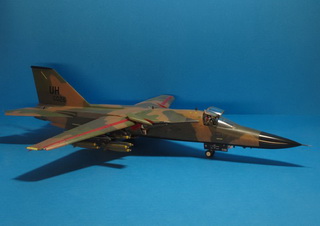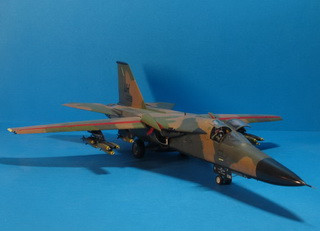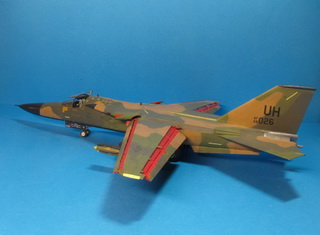Academy 1:48 F-111E Aardvark 68-0026 55th TFS/20th TFW
 The Story
The Story
The 79th TFS, 20th TFW from Upper Heyford was on a weapons training deployment in Turkey when Iraq invaded Kuwait. Because of the crisis, the 79th TFS remained at Incirlik Air Base for Desert Shield. During the course of the crisis, the 79th was augmented by aircraft rotated in from the other F-111E squadrons of the 20th TFW, the 55th TFS and 77th TFS. During Desert Shield, USAFE proposed the creation of a second front from Turkey for the air war. This proposal became Joint Task Force Proven Force which was formed into the 7440th Wing (Provisional).
On January 18th, the second day of Desert Storm, the 7440th Wing went to war. Initial air attacks involved Aardvarks flying at low level to attack Iraqi early warning radar sites which would open an air corridor much like Army Apaches did in the South on the first night. Aardvark crews struck a variety of targets including power plants, petroleum refineries, airfield, nuclear-biological-chemcial processing, and electronics sites throughout northern Iraq.
Unlike the F-111F squadrons based in Saudi Arabia, the F-111E had no capability to designate targets for laser guided bombs. To give the deployed Aardvarks precision strike capability, a force of F-4E Phantoms were deployed from Clark AFB with Pave Tack pods to designate targets for LGB carrying Aardvarks. Although the Phantoms did arrive in Incirlik, the pods did not so no combat sortie with LGBs was launched.
Without a single loss, the 23 F-111Es based at Incirlik Air Base flew 456 sorties totaling 1,327 combat hours.
The Kit
The Academy kit is pretty simple and requires some aftermarket for improvement. There are a lot of aftermarket sets available but I only choose those which would allow me to build a F-111E that is reasonably accurate. Aftermarket sets used for this build include:
Detail Model F-111 cockpit set, which is an all resin improved copy of the Verlinden cockpit, To show off the detail, I opened the canopy by careful cutting with my hobby knife. I inserted two Hasegawa pilot figures into the cockpit.
Paragon Slats and Flaps, I decided to depict my aircraft as if it were taxiing for take off so I installed the slats and flaps. I was disappointed with the fit as I had to make two cuts into one flap to shorten the flap length so the hinges would align with the associated wing parts. I had the same problem with one of the slats but solved this problem by shifting over the slots the hinges fit into.
Dmold Triple Plow II seamless intakes, these replaced the kit intakes which were wrong. All F-111E and F-111F aircraft have their intake blow in doors open while powered on the ground. Therefore I decided to cut open the blow in doors on the intakes. Replacement doors were made from styrene strip shaped to have a slight curve. The Scaledown Gear Bay set was a consideration for this build, but after examining the parts it was obvious that the Dmold intakes would conflict with the Scaledown main gear bay as it has the rear of the intakes with engine fan blades molded with the gear bay parts. I was not willing to take the effort to use both so I left the kit gear bay as it was given.
Scaledown Wheels, are much better than the kit wheels which are very plain. Scale Aircraft Conversions Metal Landing Gear with nose gear bay. This set is based on work by Scaledown and are not an exact copy of the kit parts. The main gear assembly is slightly different, the nose gear assembly is improved with the nose gear lights which the kit nose gear lacks. Also, the included nose gear bay is big improvement over the plain kit bay.
Scaledown BRU; these are an shape improvement over the kit BRUs but they required more cleanup than I expected. F-111E Aardvarks only dropped conventional unguided munitions during Desert Storm. I decided to use 14 Mk82 bombs from the Hasegawa Weapons Set A. Bombs were glued on after drilling for 2 metal pins per bomb the help align the bombs and keep them secure to the resin BRU.
After all the resin parts used, there is very few injection kit parts left to assemble. The only serious trouble area is the join between the front fuselage and rear portion but putty can fix that easily enough. The strike camera and other antennas were scratch built. Two metal pins were installed as AOA probes. I used an ALQ-131 from the Hobbyboss A-10A kit.
Airbrush work was all done with acrylics. The underside is a mixture of Tamiya Black and Tamiya Sky Gray. The topside colors are the respective Gunze Sangyo colors for the SEA paint scheme. All other paint work is done with various enamels.
For decals, I used Afterburner 48-070 Upper Heyford which has several decal options for each of the three F-111E squadrons attached to the 20th TFW. I was disappointed that although Afterburner included the RAM decals for the intakes on the F-111F sheet, they did not include them on the F-111E sheet. I used the decals on the F-111F sheet as a basis to create my own for this build. I also did not use the "no step" decals and other decals that I thought were too large for the kit. The decal for the refueling receptacle was changed from black to camouflage colors.
Overall, I liked how this kit turned out and would likely build another Academy F-111 in the future.


